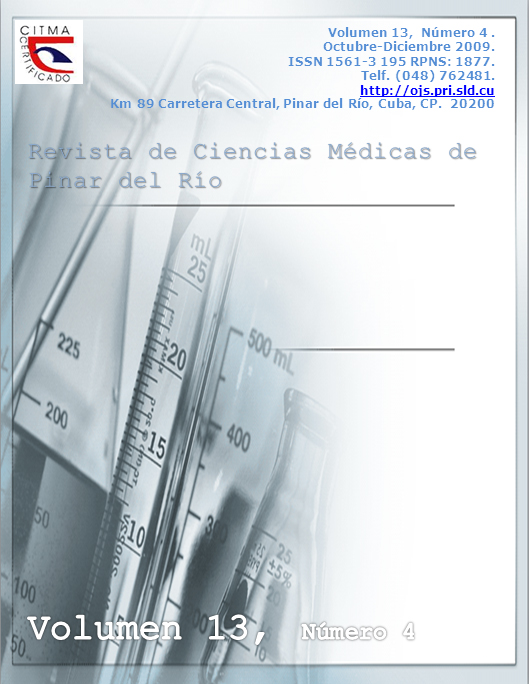Schistosomiasis en la infancia. Una experiencia para el internacionalismo médico cubano / Schistosomiasis in childhood: an experience to the Cuban Medical Internationalist Missions
Abstract
El Schistosoma es un parásito no endémico de Cuba, pero con una elevada frecuencia en los países de África, Asia y América Latina; de ellos, cinco especies infectan al hombre. No existen evidencias de dicho parasitismo en nuestro país. Con la presencia del internacionalismo médico cubano en las diversas tierras del mundo es que fue considerado útil transmitir la experiencia profesional en un país africano. Se presenta un caso clínico de un paciente de 7 años de edad, sexo masculino y estado nutricional adecuado, procedente de un área suburbana de la Cuidad de Nampula, Mozambique, África Subsahariana que al examen físico se constató que tenía lesiones de dermatitis en las manos y los pies, de varias semanas en evolución; acude por la aparición de edemas en miembros inferiores, dificultad para orinar y orinas oscuras. Se sospecha una posible Glomerulonefritis Difusa Aguda según la frecuencia de la entidad en nuestro medio. Después de una respuesta terapéutica escasa, un cambio en la visión epidemiológica y los resultados complementarios, se confirma una forma de presentación infantil de esquistosomiasis masiva, entidad frecuente en las regiones geográficas donde hoy en día está presente el internacionalismo médico cubano. Después de una revisión bibliográfica se consideró útil trasmitir la experiencia al médico internacionalista y se hacen algunas consideraciones al respecto.
Palabras Clave: Esquistosomiasis, glomerulonefritis, diagnóstico.
ABSTRACT
Schistosome is a non-endemic parasite in Cuba, but with an elevated frequency in Africa, Asia and Latin-America; of them, five species infest man. No evidences of this parasite are found in Cuba. Considering the presence of Cuban Medical Internationalist Missions in other parts of the world, it is useful to transmit the professional experience in an African country. A 7-year-old-male patient, presenting an adequate nutritional status, coming from a sub-urban district of Mampula City. Mozambique, sub-Saharan Africa, at physical examination showed dermatitis in hands and feet for several weeks in evolution. The patient attended to the clinic presenting edema in the lower limbs, difficulties to urinate and dark urines. Suspecting, a possible Acute Diffuse Glomerulonephritis according to the frequency of the disease in that environment. After a limited therapeutic response, and a change in the epidemiologic view and the laboratory results; a childhood presentation of a form of massive schistosomiasis was confirmed, a frequent entity in the geographic regions where Cuban medical missions work. Some suggestions to transmit the experience to the medical missions were made taking into consideration several aspects after a medical literature review.
Key words: Schistosomiasis, glomerulonephritis, diagnosis.
Downloads
References
1. King CH. The unacknowledged impact of chronic schistosomiasis. Chronic Illness, 2008; 4(1): 65-79. Disponible en: http://chi.sagepub.com/cgi/content/abstract/4/1/65
2. Warren KS, Mahmoud AAF, Cummings P, Murphy DJ, Houser HB. Schistosomiasis Mansoni in Yemeni in California: Duration of Infection, Presence of Disease, Therapeutic Management. Am. J. Trop. Med. Hyg. 23(5): 1974, pp. 902-909. Disponible en: http://www.ajtmh.org/cgi/content/abstract/23/5/902
3. Warren K S (eds): Tropical and geographical medicine, 2 nd ed. New York, Mc Granw- hill, 1999.Pp. 450.
4. King Ch, Kato G: Drugs five years later: Praziquantel. Ann Intern Med , 2005;(26): 117.
5. Acirema G. Nefrología pediátrica. Dial Traspl[revista en internet]. 2009[citado]; 30(4):153. Disponible en: http://www.sedyt.org/2004/revista/numeros_enteros/30_4/nef_ped.pdf
6. Luyt Dk, Green RJ, Davis G, et al.: Praziquantel peport on the costeffectiveness of Schistosomiasis in South África. S Afr Med J. 2004, 66 ( 2): 1313- 24.
7. King CH, Mahmound AA: Schistosomiais. In Guerrant RL, Walker DH, Weller PF (editors): tropical Infectious Diseases, Principles , Pathogens and Practice. New York, Churchill Livingstone, 2006. Pp. 1232 - 8.
8. Squires N. Interventions for treating schistosomiasis haematobium. Cochrane Database Syst rev; 2000; (2): Disponible en: http://www.ncbi.nlm.nih.gov/pubmed/10796476
How to Cite
Issue
Section
License
Authors who have publications with this journal agree to the following terms: Authors will retain their copyrights and grant the journal the right of first publication of their work, which will be publication of their work, which will be simultaneously subject to the Creative Commons Attribution License (CC-BY-NC 4.0) that allows third parties to share the work as long as its author and first publication in this journal are indicated.
Authors may adopt other non-exclusive license agreements for distribution of the published version of the work (e.g.: deposit it in an institutional telematic archive or publish it in a volume). Likewise, and according to the recommendations of the Medical Sciences Editorial (ECIMED), authors must declare in each article their contribution according to the CRediT taxonomy (contributor roles). This taxonomy includes 14 roles, which can be used to represent the tasks typically performed by contributors in scientific academic production. It should be consulted in monograph) whenever initial publication in this journal is indicated. Authors are allowed and encouraged to disseminate their work through the Internet (e.g., in institutional telematic archives or on their web page) before and during the submission process, which may produce interesting exchanges and increase citations of the published work. (See The effect of open access). https://casrai.org/credit/



